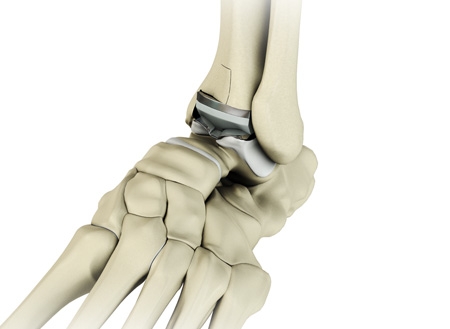In the great realm of joint replacements, the total ankle arthroplasty is one of the lesser known procedures. Despite not being widely known, ankle replacements have actually been around for years and years. Dr. Zhu is our ankle replacement expert here at Orthopaedic Associates of Wisconsin. He has been treating ankles at OAW for nearly 20 years.
Like other joint replacement surgeries, an ankle replacement is intended to alleviate the pain associated with arthritis in the ankle joint. If patients have failed conservative treatment, they may be a candidate for a replacement if the alignment of the joint is maintained. Patients with a mal-aligned ankle joint, oftentimes because of diabetes, may be better served with an ankle fusion-more to come on that in a later blog! The benefit of an ankle replacement is that the normal mechanics and motion of the joint can be maintained.
The implant that Dr. Zhu uses is called the STAR which stands for Scandinavian Total Ankle Replacement. This implant has 3 components: one piece covers the end of your tibia bone, one piece covers the talus bone, and the third piece called the Mobile Bearing is placed between the other two implants. This implant is made of a cobalt chromium alloy, just like implants used in knees and hips. The Mobile Bearing place is made of polyethylene. The incision is made directly over the front of the ankle joint and closed with nylon sutures.
Recovery from an ankle replacement is not typically as arduous as recovering from the standard knee replacement surgery. When Dr. Zhu is done with the procedure, he will place you in a lower leg splint for the first 10 days to immobilize the joint while the soft tissues begin to heal. At your post-operative appointment, that splint will be removed as will the sutures. Dr. Zhu will order x-rays to confirm that the implant looks appropriately aligned.Then, you will be placed in a pneumatic walking boot while you begin partial weight bearing up to 50 pounds using a walker.
Similar to other joint replacements, a course of formal physical therapy will be necessary to regain proper function of the ankle and foot. As the strength and motion in the lower leg improve, the patient can wean from the walking boot and begin ambulating normally as their discomfort allows. Over the course of several months, strength and motion will continue to improve and patients start to get back to regular activity. This replacement has proven to be remarkably effective in allowing patients to return to doing their normal activity with minimal pain. If you are struggling with arthritis pain in your ankle, schedule an appointment with us today!
This blog is written by one of our very own-Morgan. She is a certified athletic trainer working in our clinic with our providers each and every day. She obtained a bachelor's degree in athletic training from Carroll University in Waukesha and a master's degree in Kinesiology from Michigan State University.

